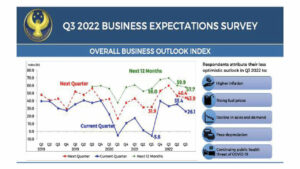Budget funding sought for food imports to serve as price stabilization ‘buffer’

THE Department of Agriculture (DA) asked legislators on Monday for a P513-billion budget to import farm products that it plans to tap as a reserve to bring under control the widening gap between farmgate and retail prices.
The DA proposed maintaining a reserve equivalent to 10 days’ worth of demand for key commodities.
“Our problem is not only a short-term issue but a long-term, systemic issue,” DA Policy Research Service Director Jerome D. Bunyi told in a House Trade and Industry Committee hearing. “We have a proposal allowing us to have a buffer fund, allowing us to procure and import (goods),” he added.
House legislators were looking into the wide gap between farmgate and retail prices of basic goods.
To solve price discrepancies, Perpetua Werlina C. Reyes-Lim, a division chief for enforcement at the Department of Trade and Industry’s Fair Trade Enforcement Bureau, said such a reserve of commodities has legal authorization from the Price Act.
“There is a provision in the Price Act that an agency can implement an appropriation fund to have a buffer fund,” she said. “This would allow imports, especially for the DA, because the entry of more stocks (of basic goods) would reduce prices.”
The commodity reserve is designed to deter hoarding, she added.
The divergence of farmgate and retail prices was noted in the DA’s report to the panel.
“The presentation clearly shows that farmgate prices are too low compared to retail prices,” Surigao del Sur Rep. Romeo S. Momo, Sr. said.
“Processing costs, marketing margins, and consumer preferences (influence) retail pricing,” Junibert E. de Sagun, DA director for agribusiness and marketing assistance services, said.
Farmgate prices are mostly influenced by “supply and demand dynamics, weather conditions, transportation costs, and marketing competition,” he added.
Steven T. Cua, Philippine Amalgamated Supermarkets Association executive director, said retailers are only putting an “8%” gross margin for “fast-moving” produce and a “10%” margin for refrigerated goods, to account for electricity costs.
The divergence in the prices indicate that “someone in the middle is earning,” Iloilo Rep. Ferjenel G. Biron, who presided over the panel, said.
The House is planning on inviting traders and importers to explain the price disparities, Speaker and Leyte Rep. Ferdinand Martin G. Romualdez said in a statement. — Kenneth Christiane L. Basilio




